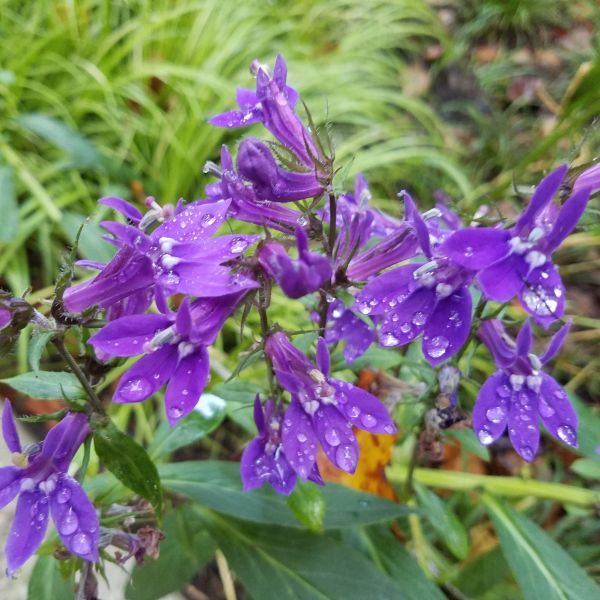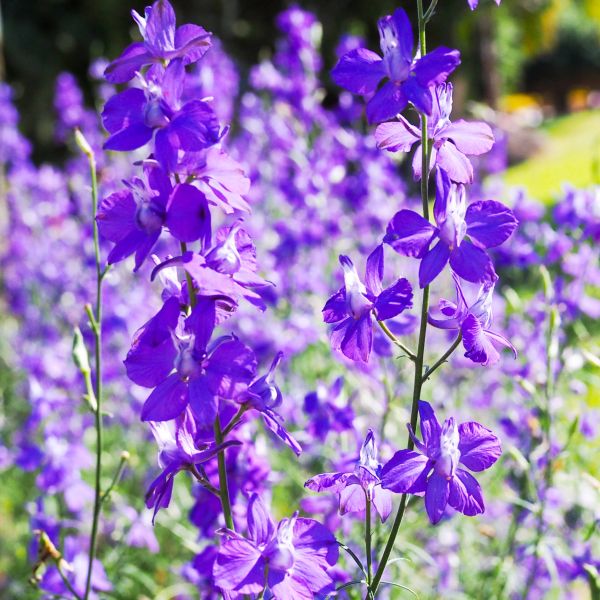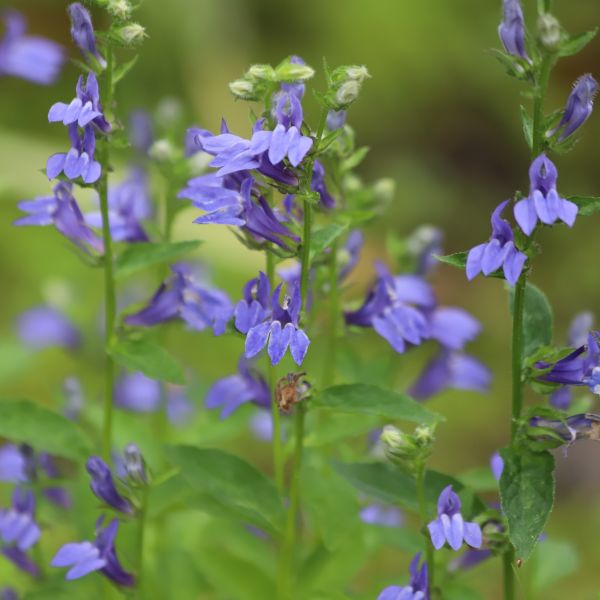


Great Blue Lobelia
Lobelia siphilitica
86 reviews
Great Blue Lobelia
Lobelia siphilitica
86 reviews
- Beautiful blue flowers add a pop of color to any garden
- Tolerates wet soil, making it a great choice for boggy areas
- Attracts butterflies and hummingbirds to your garden
- Recommended by landscape designers for optimal fit in real yards
$43.00
$62.00
30% Off
- Ships to in 3-5 Days
- Free Shipping Over $150
- Plant Arrival Guarantee
- In Stock
- Free Plant Consult
$200 - Landscape-Approved: Every Plant We Sell Comes With Design Expertise Behind It
1 Gallon
We are sorry, product is currently out of stock due to seasonal availability. Please check the "Related plants available in your area" section below
Not just beautiful - intentionally selected by ShrubHub's 3D landscape design team to fit real-world spaces and maximize yard potential.
Why Great Blue Lobelia?
Great Blue Lobelia (Lobelia siphilitica) is a North American wildflower that is often found in wetlands and along streambanks. It is known for its striking blue flowers that resemble small trumpets and bloom from mid-summer to early fall. In addition to its aesthetic appeal, Great Blue Lobelia also provides important habitat for pollinators such as bumblebees and hummingbirds. The plant has also been used medicinally by indigenous communities for a variety of ailments.
Sunlight
Great Blue Lobelia requires full to partial sunlight exposure. It grows best in areas that receive at least 6 hours of direct sunlight each day but can tolerate some shade.
Watering
Great Blue Lobelia prefers consistently moist soil and is typically found growing near streams, ponds, or wet meadows. It requires regular watering to ensure the soil remains damp but not waterlogged.
Fertilizing
Great Blue Lobelia thrives in moist, rich soils. It benefits from a balanced fertilizer with equal amounts of nitrogen, phosphorus, and potassium. Avoid excessive fertilization as it may lead to more leaf growth than flowers.
Great Blue Lobelia: Your Ticket to Endless Blue Beauty
Looking to add a touch of nature's magic to your garden? Say hello to the stunning Great Blue Lobelia!
With its long-lasting bright blue blooms and undeniable charm, this plant is a must-have for both seasoned gardeners and beginners alike.
Picture this: vibrant blue blossoms dancing in the breeze, transforming your garden into a sea of serene blue hues.
The Great Blue Lobelia's unique feature lies in its ability to maintain its dazzling color through mid-autumn, providing a constant source of beauty and wonder.
Not only will your garden be a visual treat, but it will also become a haven for pollinators, making it a crucial pit stop for our buzzy friends.
Standing at a perfect size, the Great Blue Lobelia loves to line garden edges, creating a natural and effortless border that draws the eye and invites exploration.
This versatile plant thrives in full sun to partial shade, adapting beautifully to various light conditions.
And here's the best part: it's not too picky about soil types. Tolerating wet soil like a champ, this Lobelia is a symbol of resilience and adaptability.
Maintaining this garden gem is a breeze. With a medium growth rate, you won't be chasing after runaway shoots. A little bit of love and moderate moisture will keep it flourishing.
The lush green foliage provides an ideal backdrop to those captivating blue blooms, creating a harmonious balance of color that's soothing to the eyes and soul.
The Great Blue Lobelia is your ticket to a garden that'll be the envy of the neighborhood.
Make your garden come alive with nature's most mesmerizing shades of blue.
Visit our ShrubHub store and make the Great Blue Lobelia a part of your garden today!
Your garden will thank you, and you'll be thanking yourself every time you lay eyes on this botanical masterpiece.
Plant Information:
| Botanical Name: | Lobelia siphilitica |
| USDA Zones: | 4 - 9 |
| Water: | Moderate to High - Tolerates Wet Soil |
| Exposure: | Full Sun |
| Soil Needs: | Adaptable |
| Mature Height: | 2 - 3 feet |
| Mature Spread: | 18 - 24 inches |







Pollination Info
Pollination Info for Great Blue Lobelia (Lobelia siphilitica)
Great blue lobelia is a native wildflower found across much of the eastern United States, from Maine to Georgia and in the Midwest. Its flowers are primarily blue, but can also be white or pink.
The plant is pollinated by a variety of insects, including bees, butterflies, and moths. The shape of the flower, with a long, narrow tube and a wide, open throat, is an adaptation for pollination by long-tongued bees like bumblebees. The bees insert their tongues deep into the tube to reach the nectar, brushing against the pollen-producing anthers and stigma.
The flowers are also visited by hummingbirds, which can access the nectar with their long bills. However, they are not efficient pollinators because they usually do not come into contact with the reproductive structures of the flower.
Great blue lobelia blooms from mid-summer to early fall, providing a valuable nectar source for pollinators during this time. Its attractive blue flowers make it a popular plant for gardens and natural areas.
FAQ
Great Blue Lobelia (Lobelia siphilitica) FAQ
1. What is Great Blue Lobelia?
Great Blue Lobelia (Lobelia siphilitica) is a species of flowering plant in the Lobelia genus. It is native to North America and is known for its vibrant blue flowers
2. What are the growing conditions for Great Blue Lobelia?
Great Blue Lobelia prefers partial shade to full sun and moist, well-drained soil. It is often found in wetlands and along stream banks but can also be grown in gardens and containers with consistent moisture.
3. When does Great Blue Lobelia bloom?
Great Blue Lobelia typically blooms in late summer to early fall, from August to September. It produces striking spikes of bright blue flowers that can grow up to 2 feet tall.
4. Is Great Blue Lobelia deer-resistant?
Yes, Great Blue Lobelia is considered deer-resistant. Its bitter taste and toxicity make it unappealing to deer and other mammals.
5. Can Great Blue Lobelia be grown in containers?
Yes, Great Blue Lobelia can be grown in containers as long as they are consistently moist and in partial shade. The plant may need to be watered more often in containers than in the ground.
6. How do I propagate Great Blue Lobelia?
Great Blue Lobelia can be propagated by seed or by division. Seeds can be sown in the fall or early spring, and division should be done in the spring. To divide the plant, dig up the clump and separate it into smaller pieces, making sure each piece has roots and shoots.
7. Can Great Blue Lobelia be invasive?
Great Blue Lobelia is not considered invasive but it can self-seed readily if conditions are right.
8. Are there any pests or diseases that affect Great Blue Lobelia?
Aphids, spider mites, and slugs can sometimes feed on Great Blue Lobelia. Powdery mildew and rust can also affect the plant, especially in humid conditions. Providing good plant hygiene and spacing plants to increase air flow can help prevent disease.
Planting & Care
Planting and Care for Great Blue Lobelia (Lobelia siphilitica)
Planting
- Great Blue Lobelia thrives in moist, well-drained soil, but can tolerate some shade.
- Plant seeds or transplants in the spring, after the last expected frost.
- Sow seeds 1/8 inch deep and 12 inches apart for optimal growth.
- Water well after planting and regularly thereafter to keep the soil consistently moist.
Care
- Great Blue Lobelia doesn't require much care, but regular watering and fertilizing can help promote healthy growth.
- Deadhead spent blooms regularly to encourage new blooms and maintain a tidy appearance.
- Pinch back stems in the spring to encourage more branching and fuller growth.
- If growing in a container, make sure it has drainage holes to prevent waterlogging.
- Protect from strong winds and heavy rain, as the tall stems can become damaged.
Pests and Diseases
- Great Blue Lobelia is generally resistant to pests and diseases, but may be susceptible to powdery mildew.
- To prevent powdery mildew, avoid overhead watering and allow good air circulation around the plant.
Check Out These Verified Customer Reviews:
Customer Reviews
4.7 out of 5 based on 86 reviews
Thank you! Your review has been submitted.
Quick delivery and well-packaged.
Excellent quality and fast shipping.
The quality of the Great Blue Lobelia is top-notch. It looks stunning in my garden and has brought so much color to my yard.
Item has been added to your cart.


